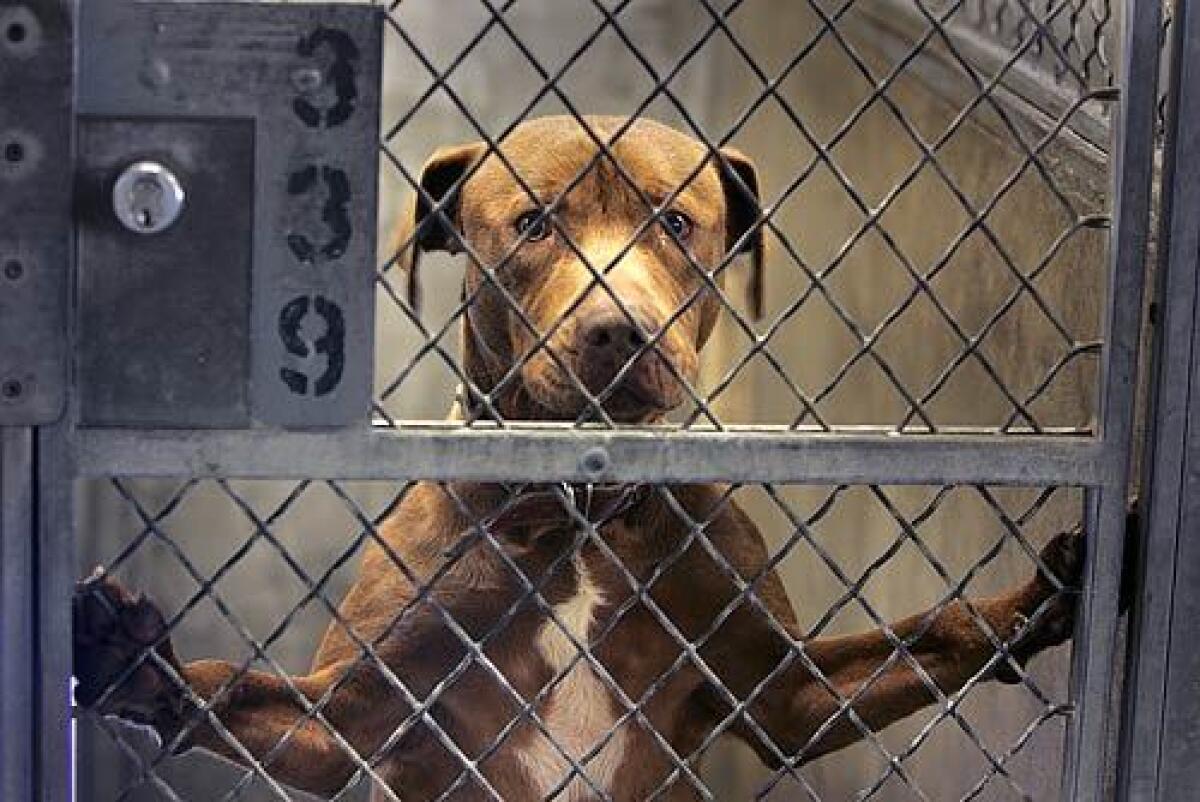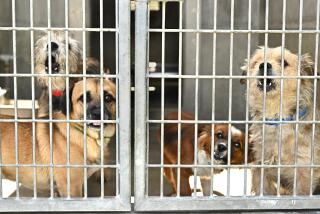Animal shelters are under scrutiny

Public animal shelters will never look like -- or be run like -- the Four Seasons. But according to animal welfare activists, volunteers and private rescuers, the shelters operated by the Los Angeles County Department of Animal Care & Control sometimes resemble dog pounds of yore.
For months, animal advocates have made allegations of transgressions in the nation’s largest municipal shelter system, including overcrowded and filthy conditions, a failure to administer medications and the euthanasia of healthy animals before the mandatory minimum four-day waiting period was up.
The drumbeat of criticism peaked last year, with the death of a 10-month-old female Lab mix named Zephyr in the Carson shelter. A volunteer’s photo of the dog’s stiff, outstretched body lying on the concrete floor of its kennel ricocheted through blogs and e-mails of rescuers, volunteers and animal lovers.
Three civil lawsuits, alleging poor conditions and mistreatment, have been filed against the county by various rescue groups and a coalition of volunteers and animal advocates.
After the barrage of complaints, county Supervisor Yvonne B. Burke sent deputies to review conditions at the Carson shelter and then ordered Marcia Mayeda, the director of the county’s animal care agency, to report to the board on the Carson facility and the death of the puppy. Mayeda is expected to appear before the board today.
Coming into a shelter system “like this and trying to make change is like trying to change direction of the Titanic -- or an aircraft carrier,” said Mayeda, who has been at the helm of the department for 6 1/2 years. “Change doesn’t happen overnight. I can put out great new policies -- and that’s the first step -- but then the next step is getting everyone to buy into them.”
During the last fiscal year, which ended in June, the county system took in 85,975 animals, roughly a third more than the city of Los Angeles. That number includes cats, dogs, rabbits, snakes -- even livestock. In the same year, the county euthanized 16,989 dogs, 26,384 cats and 9,429 other animals.
County shelters, which serve unincorporated areas of the county as well as contract cities, are located in Agoura, Castaic, Baldwin Park, Downey, Lancaster and Carson.
Mayeda would not speak about specific allegations in the lawsuits, but she talked about the shelter system in general, which, she says, struggles to cope with a huge population of unwanted animals that arrive at county shelters.
Shown pictures of animals crowded, sometimes as many as eight to a kennel, in a Lancaster shelter, she said, “I would like to see that cut in half.” But she noted that some of the photos circulated on the Internet show animals curled up together. “If you look at them, they’re all cuddled up together. They’re not fighting.” Mayeda said the county planned to build another animal shelter in the Antelope Valley, which will relieve some of the crowding at the Lancaster facility.
Stray animals are held at least four days, not counting the day they are impounded. If the animal is microchipped or tagged, it is held 10 days as the county tries to find the owner. Sick or injured animals whose suffering can’t be alleviated may be euthanized right away. After that time, animals can be put up for adoption -- or euthanized.
Space is at a premium in some shelters. Mayeda acknowledges that animals that stay for lengthy periods may become stressed by the time spent in kennels. Kennel cough and other respiratory ailments can spread quickly through the close quarters of a shelter.
“If we run animal shelters, we have to do it responsibly. And part of that means managing the population,” said Mayeda, 43, who brings her own Great Pyrenees dog (a rescue) to work in Long Beach. “Nobody that works at animal shelters that I’ve ever met likes killing animals. It’s unfortunately a necessary part of the job for the greater health of the population at the shelter.”
Part of what keeps animals moving out of the system is the network of private rescue organizations that take animals and place them in homes, often on the eve of their scheduled euthanasia. Volunteers help staff the shelters and alert private rescuers to animals they might want to take.
According to Mayeda, Zephyr entered the shelter Oct. 27 and was put on a “hold” by a volunteer Nov. 2. A hold means a volunteer will return within a few days to take the animal and arrange for an adoption or transport it to a rescue group. Mayeda said that while on hold, Zephyr became ill and was treated successfully. But the animal became sick again, and on Nov. 27, the shelter vet recommended that it be euthanized. The dog was found dead the morning of Dec. 1 by two volunteers.
Although some activists and rescuers said the cold contributed to the dog’s death, an independent necropsy found that Zephyr died of pneumonia. In addition, Mayeda said in her report, the Carson shelter’s heating system was working and the night temperature was in the low 50s.
In her report, Mayeda says the dog should have been moved out of the shelter sooner and notes that Zephyr was on hold for a month. “You can’t put a hold on an animal and keep it in limbo,” Mayeda said in an interview.
Although Mayeda did not name the volunteer in the interview or her report to the board, the volunteer, who says she has been suspended by shelter officials from her volunteer work for unknown reasons, has a different story. Janet Taylor, who worked a little more than a year as a volunteer at Carson, denied she ever put an official hold on Zephyr. She did look at Zephyr and asked staff to call her if the dog was about to be put to sleep, or “PTS,” as staffers call it.
“The actual note read ‘If to PTS, call Janet Taylor,’ ” she said. “In other words, if she’s in any kind of danger, if the shelter is full, call Janet Taylor. I never got a call about her -- ever.”
Taylor said it was only by chance on a walk through the shelter on Nov. 30 that she saw how sick Zephyr was and then scrambled to line up a rescuer. The next morning, the dog was dead.
“I was a really good volunteer,” Taylor said. “It’s unthinkable that they’ve done this to me. I didn’t kill that dog.”
Taylor contends the Carson shelter was woefully understaffed, meaning animals sometimes didn’t get their prescribed medications.
More to Read
Start your day right
Sign up for Essential California for news, features and recommendations from the L.A. Times and beyond in your inbox six days a week.
You may occasionally receive promotional content from the Los Angeles Times.







